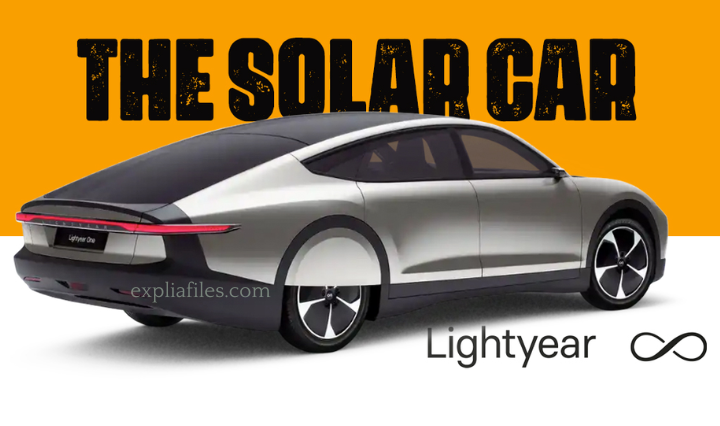The Dutch startup Lightyear has apparently abandoned its solar car plans. In a recent press release, Lightyear one announces a change of management to focus on the introduction of on-board solar charging systems for the automotive industry.
Read about upcoming OLA electric car.

Key Specifications:
| Lightyear One | Five-door liftback, 5057 x 1898 x 1426 mm, Solar-electric, In-wheel motors |
| Maximum battery capacity | 60 kWh |
| Maximum range between charges | 725 km |
| Optimal energy use | 83 Wh/km (141 Wh/km in winter conditions) |
| Maximum continuous speed (capped) | 160 kph |
| Maximum power output (capped) | 80 kW |
| Acceleration | 0-100 kph in just under 10 seconds |

Ray of sunshine of Lightyear one
Rory Jackson explains how this aerodynamic five-seater has been designed for daily trips purely on solar power
Netherlands-based Lightyear one has answered this with a resounding ‘Yes’. Since 2016, it has worked to achieve its vision of a highly efficient solar EV it says will do much to ease range anxiety.
That EV is the Lightyear One, which is ready to go into collection manufacturing later this year. This five-seater car’s roof and hood are included in photovoltaic (PV) cells that take a seat down atop a frame and chassis designed round optimising aerodynamics and weight. It also contains a list of parts balanced around maximising energy efficiency, so that the PVs provide the kinds of ranges and speeds consumers expect from 21st century technology.
As a result, Lightyear’s launch car has a maximum range of 725 km between charges and an optimal energy consumption rate of 83 Wh/km, as measured in the WLPT (Worldwide Harmonised Light Vehicles Test Procedure). Its solar panels recharge the battery packs at a rate that gives on average 0.7 kph (although a charger input is installed at the rear, which charges at 570 kph with a 60 kW supply), and the car features four in-wheel motors independently controlled via SiC inverters that allow it to accelerate from 0 to 100 kph in just under 10 seconds, up to a speed cap that is currently fixed at 160 kph.
Its efficiency is such that it has reached distances of 710 km in tests at Aldenhoven, Germany, on just a single charge of its 60 kWh pack and at an average speed of 85 kph (over 9 hours) in typical weather conditions for the region. It has also managed just over 400 km in winter tests (10 C and cloudy conditions) at Bridgestone’s track in Aprilia, Italy, while maintaining 130 kph.
In the latter trial, it maintained an energy consumption rate of 141 Wh/km, a figure the company cites as two-thirds of the consumption of comparable EVs under similar test conditions. It also claims that other such EVs would only achieve about only 265 km range on a 60 kWh battery pack.

Lightyear one’s timeline
While that may seem a staggering target, van der Ham points out that roughly all the cars in the world today collectively drive about one lightyear one of distance annually. After raising capital (much of which came from the various parties from their WSC days and subsequent showcases of the Stella) Lightyear established its offices in Helmond, near Eindhoven.
Concept development of the company’s first car started in 2017, with these early stages dominated by spreadsheets of energy consumption, solar yield and other metrics, as well as some concept design sketches. This gradually progressed towards 3D models indicating how trade-offs between aerodynamics and solar panel area might affect the final look of the car.
“These were the models we used for the public launch of the car and the first unit reservations in June that year,” van der Ham says. “It actually looked very similar to what we have now, but of course everything underneath changed. We only had 20 people back then so the technical content wasn’t anywhere near as developed or mature as it is now.”
From 2018 to ’19, the engineering team worked on efficiency calculations to determine the powertrain’s layout, aerodynamics, solar car architecture and ergonomics, along with other packaging concerns. These have been vital to the vehicle’s performance capabilities, and led to the unveiling of the prototype in June 2019.
The aerodynamics have remained much the same, with most r&d thereafter concentrating on maturing the motors, solar car panels, inverters and related electronics.
In June 2021, the performance was extensively validated using single Lightyear One prototypes across standardised trials, which established its 700-plus km range capability using less than 60 kWh at 85 kph.
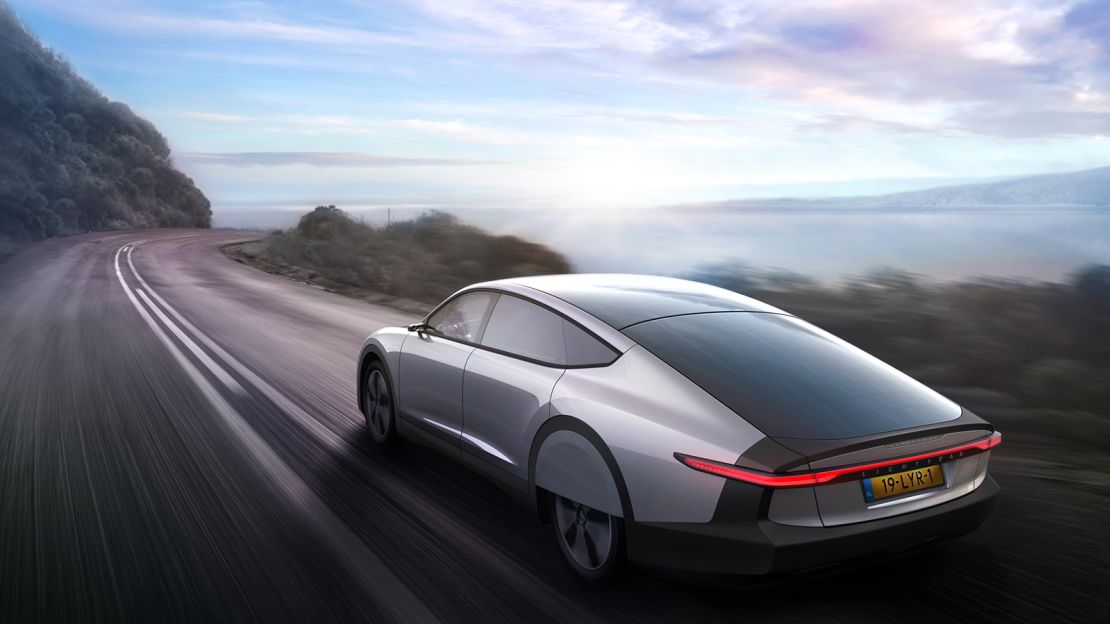
In-wheel motors
Each of the four motors is a radial flux, permanent magnet AC machine with distributed windings. The concept design was produced internally before an (undisclosed) external supplier was contracted for more detailed design and manufacturing.
“We did look at axial-flux motors for some time, and we’re just on the edge of where it might make sense to do so, in terms of diameter versus axial length, as well as torque density,” van der Ham comments. “But in the end we went with radial flux because it makes air gap control easier.
“We tried it with axial flux, we built a prototype, and found it so much more difficult for in-wheel motors. If you hit a kerb or just corner hard, your sub-1 mm air gap is gone and your motor is ruined.”
The motors also use bearings that are chosen for their extremely low roll resistance. Physics dictates that the bearing (mainly its robust environmental protection seal) still causes one-third of the motor’s efficiency loss, despite being the best Lightyear could find. As a result, the motors reach a peak efficiency of 97% in tests and an average of 93% over cycles, with an average efficiency across the drivetrain (battery to wheel) of around 91%.
“The motors are actually over-designed for what they need to deliver, just so that they run more efficiently at the points we’re actually using them for,” van der Ham says. “We’re getting 20 kW out of them but on the dyno you can pull 40 kW from them easily, albeit with heavier cooling.
“We don’t need to; we just put more copper into them to make sure they run efficiently at the low power levels needed for gentle commuting. Most other motors lose a ton of efficiency at low revs.”
He adds that the choice of in-wheel motors (rather than e-axles or a central drive) wins out in Lightyear’s view on mechanical efficiency grounds too. As noted, even high-quality bearings cause one-third of efficiency losses – every additional bearing, belt, differential and so on will cause further losses, he says, making it (in his view) impossible to reach 91% efficiency across a whole drivetrain with e-axles or central drives.
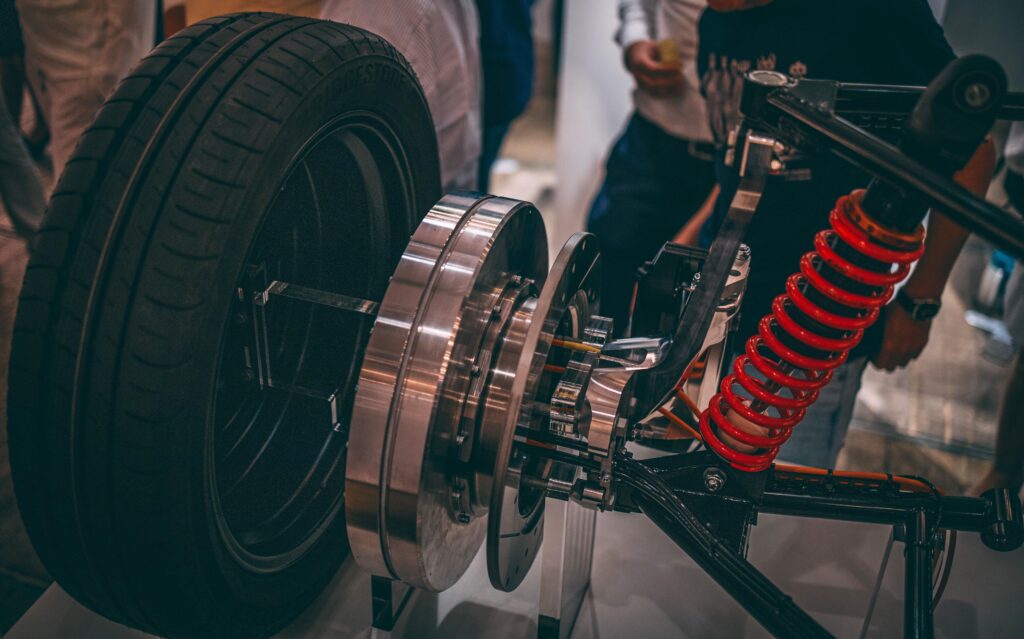
“The industry is flooded with companies shouting about how their EV has a 95% efficient motor, but then they never include the gearboxes, the shafts, the bearings from the motor to inside the wheels, because if you did, their battery-to-wheel efficiency would typically be 70-85%,” van der Ham comments.
Much of Lightyear’s motor r&d went into optimising the placements of magnets, minimising end-windings and reducing eddy current losses in the back-iron by using appropriately thin stator laminations. The design features 30 pole pairs, a high number chosen to ensure the electrical frequency (32 kHz) can easily match the mechanical frequency, as discrepancies here would cause losses.
“Being 0.5º off is enough to cause losses, so we use an observer in the inverter to measure the waveforms in real time against an embedded model of one phase,” van der Ham explains. “That gives us the position of the motor and allows us to really maximise the accuracy and timing of the commutation.
“There are some other tricks in the inverter to help with that, such as very accurate delay compensation, a reliability signal for the observer, and the wheel encoders serve as back-ups when the reliability signal calls for them.”

Solar on top
Lightyear uses monocrystalline silicon (mono-Si) cells, partly because it found a secure supplier in Maxeon Solar car Technologies. They were also chosen because Maxeon cells are rated at a solar conversion energy efficiency of 25.1%, which was deemed the best in terms of cost versus performance.
“If you really want to max-out the efficiency on your solar car recharging, you need to go to something akin to the triple-junction, GaAs-based panels used in satellites and high-altitude solar drones, which would make our cars not affordable for anyone,” van der Ham says. “Even single-junction GaAs cells would have cost €150,000 by themselves, just for one car’s roof. That’s simply not worth it, not even for the 27-28% solar-to-electricity conversion efficiency they’d bring.
“Maxeon have made the most efficient mono-Si cells for years. That said, we do quite a bit with the cells before we actually put them on the car.
Once received by the Lightyear One’s engineers, the square-shaped cells are cut into smaller sizes to make them fit the 2D dimensions and 3D curvature of the roof and hood without cracking. While flexible, the crystalline structure of each Maxeon panel is such that it will only bend along one axis at a time (like card or paper), so the pure product cannot simply be bent and bonded onto the car if its aerodynamics are to be preserved.
“We buy small cells, as they are easier to shape to our geometric tolerances, and we also buy glass and lamination materials selected to minimise reflections as well as damage from hail, gravel and scratches from other sources,” van der Ham says. “We’ll continue producing our own modules in series production as well though.”
In addition to construction methods, solar electrical engineering has been a major focal point for Lightyear pne. A typical solar cell will output around 0.5 V and 2 A; this low-voltage, high-current supply contrasts with feeding battery cells, as they tend to be high-voltage and low-current by comparison.
“If you want a really efficient solar-to-battery energy supply, you need to put your voltage up,” van der Ham explains. “Typically, that’s done by connecting a couple of hundred cells in series. That gives you 50-100 V, which can be efficiently stepped up to maybe 400 V for the battery.
“The problem with that though is that a string of series-connected cells needs the current running through to be equal all the way, and the current in a solar cell is determined by the amount of sunlight it receives. With a curved roof, you’ll never have all the cells getting equal sunlight: each sunrise, the cells facing the west will limit the current generated in the cells facing east.
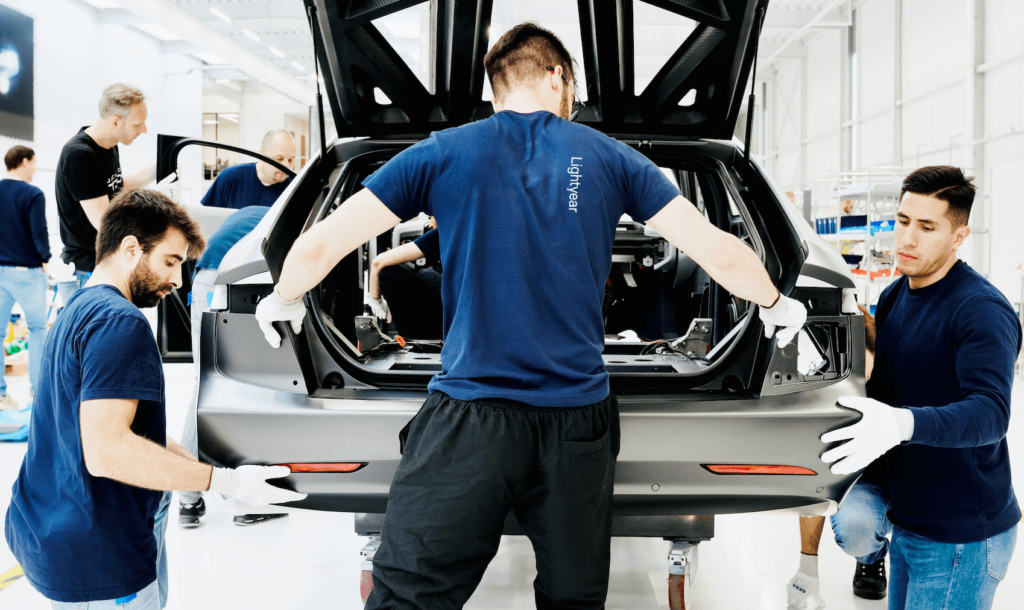
A maximum of 946 Lightyear Ones will be manufactured and sold, with production to start at the end of summer 2022
Silicon carbide inverters
Each motor has its own SiC inverter mounted nearby on the chassis, connected via cables running over the suspension assemblies. As mentioned, the inverter was designed entirely in-house, as after a year of searching Lightyear could not find a COTS inverter that matched its efficiency and packaging requirements.
“We’re not using SiC for extremely high power switching, as most others are,” van der Ham explains. “For us, the real benefit is that it allows us to simplify our thermal management massively. By making the inverters really efficient, we almost never have to cool them, except for the bare minimum just to keep their temperature a bit consistent, for reliability’s sake, but it really reduces the power drawn by our cooling system.
“We could even run them air-cooled. We’ve tested them enough to see that airflow would be sufficient, but again that’s something that would take away from our aerodynamics, so liquid was the best option.”
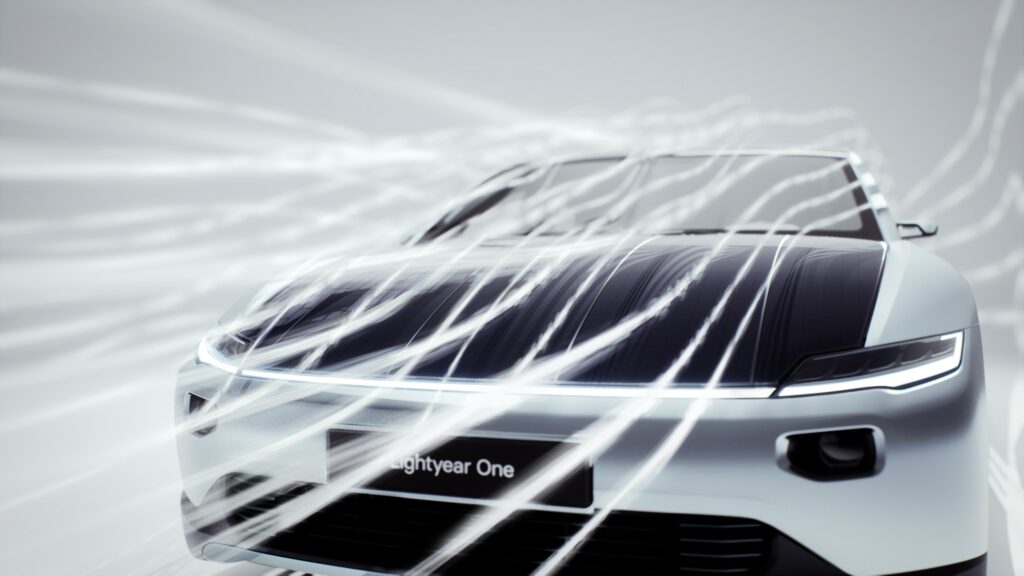
The goal of maximising the rate of ‘solar-kilometres’ was critical to the Lightyear One’s powertrain and aerodynamic engineering
Thermal management
The Lightyear One’s thermal management system consists broadly of a refrigerant circuit and a coolant circuit; the former can also work in reverse, to work as a heater in cold weather. A heat exchanger is installed between the two circuits, and the refrigerant circuit can run through it or not, depending on the mode selected.
“That means we can actively heat or cool the water-glycol medium in the refrigerant system,” van der Ham says. “We can direct the refrigerant circuit to take heat from the battery or motors to heat up the cabin for example, including our heated seats. That makes a lot of sense since people generally like to be about the same temperature as batteries, around 20-25 C.”
He adds that the coolant circuit splits into two loops: one for the forward motors and one for the rears. Each of these splits off into an additional loop for other components – one for the onboard charger and the HV-to-LV DC-DC converter, the other for the battery packs, which can be toggled to work in series (as a single loop) or in parallel (single input and output but with multiple channels between) with the rear motor cooling loop.
“The main reason for that is because, upon starting the vehicle, you might want to cool both, for which series and parallel are both fine,” van der Ham says. “But if you need to extract heat from the motors and use it to cool the batteries, a series loop works best, and if you want the refrigerant loop heated via the heat exchanger then we use the parallel mode.
“Eventually, once the battery is at operating temperature, you might start pushing it and start generating surplus heat, but the coolant circuits pass through a radiator as standard, so if more cooling is needed we can send excess heat into the refrigerant loop through the heat exchanger.
“It’s an effective but very complex system; we’ll probably simplify the thermal management in future models.”
Future plans
In addition to the upcoming production of the Lightyear One, and of the high-volume Lightyear Two design, the company plans to develop autonomous robotaxis. Its engineers see such vehicles as the best way to achieve its core goal of clean mobility for all, and they anticipate that they could tackle autonomy with a similar speed and effectiveness with which they have approached electrification.
It is worth noting that this has been made possible through Lightyear one deliberately breaking the mould early on in their approach to automotive design. Van der Ham notes that most new car models are conceived with an array of core components – engines, transmissions, suspensions and so on – that a chassis and body are designed around.
Since the 1950s, the traditional model of engine in the front, driveshafts to the sides, steel stand monocoques and so on has been held sacred. Yet reversing the conventional order has enabled Lightyear to reach new heights in efficiency, and position itself as the Tesla of solar e-mobility.
“No dominant model of design flows or even vehicle architectures has emerged in EVs, but we’re ahead of everyone else in terms of our car’s efficiency and practicality, especially when it comes to making something that consumers can use for all their daily routines without having to stop and charge,” van der Ham says.
“If you look at the current offerings from Tesla, Hyundai, Ioniq and others, we are almost twice as efficient. We also have all the resources we need to keep our r&d moving faster than theirs, so we’ll stay ahead with each new model we put out.”
